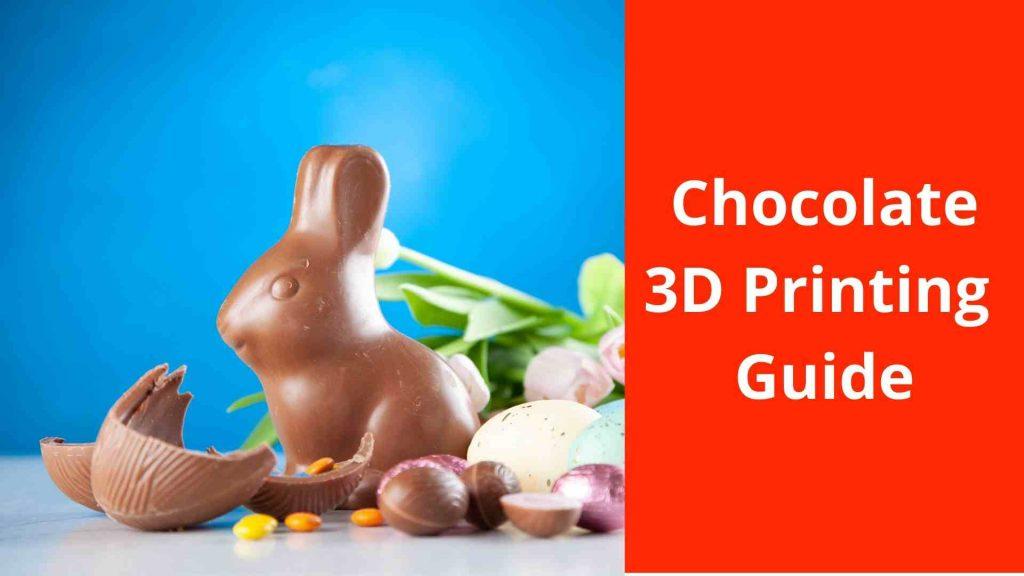The chocolate industry is yet to peak. But the advent of 3D printing has definitely given the chocolate industry a never seen high. Never knew that 3D printing can be so delicious.
Additive manufacturing is now popular across a range of food markets. It was a matter of time before 3D printing made inroads in the chocolate industry.

Traditionally molds are used to give chocolate their desired shape, in this process melted chocolate is poured inside the molds and kept inside freezers to solidify, with the advancement of technology 3D printers are being used for this process.
In simple, words we can say it is a 3D printer installed inside the fridge.
Chocolate 3D printing is still at its nascent stages and requires lots of development, the initial market for this industry would be a small bakery, this would only be possible once this printer is widely available. Imagine your name on the cake being written by chocolate, this would be really nice. One would be able to get any customization.
So, nowadays, the focus lies on the edible creations of chocolate.
How does 3D chocolate printing work?
The chocolate 3d printer works on the principle of the traditional FDM 3D printer. Instead of a plastic filament chocolate is used for the print, Like all the 3D printing processes, a CAD file is converted to an STL file with the help of slicing software.
Usually, the print chamber of a chocolate 3D printer is made from stainless steel. This ensures the build area can be cleaned easily for food safety, even the extruder of the chocolate 3D printer is covered with stainless steel.
Inside the extruder of this printer, chocolate is loaded in a syringe like structure through which chocolate gets extruded. The nozzle of these printers is usually bigger they are approx 8mm
Upon moving around, the extruder head extracts melted chocolate. Chocolate is laid down layer-wise, in the shape desired.
The movement of the extruder is done through the CoreXY motor. In this two motor work simultaneously to get the desired shape. This acts as a performance improvement.
Over time, as the chocolate cools down, it solidifies. This whole 3D printing process happens inside a mini fridge. As it is very important for the chocolate to solidify quickly else one will not be able to get the desired shape.
Temperature dependence of chocolate 3D printer
Chocolate 3D printing requires different temperatures to be maintained throughout the printing process and even a slight variance can disrupt the whole print.
At the time of loading the chocolate is in a solid state. Which is melted inside the extruder, if the temperature at the time of extrusion increases too much this would result in unnecessary dripping of the chocolate from the nozzle. If the temperature is kept low this might freeze the chocolate and block the nozzle
Earlier it used a system known as refrigerated airstream but now this process has been upgraded now vapor compression refrigerated system is being used. This vapor compression refrigeration system ensures the build chamber stays at just the right temperature.
This problem is not faced with FDM printers as in comparison to chocolate plastic filaments cool down more easily and are sturdy after print. This nature of filaments makes them more favorable as a substance as it adds more durability to the prints.
Hence for smooth and uninterrupted prints temperature of the printer needs to be perfect.
Does 3D chocolate printing have any limitations?

Chocolate 3D printing is at a nascent stage. It is challenging and requires a lot of practice and time to print a chocolate model. The upside to this is that even the distorted prints taste the same as the regular so one can eat their own mistakes, unlike the FDM printer where failed prints lead to wastage of the filament.
Currently, chocolate 3D printers are unfit for mass production. But, when one intends to create some personalized pieces, chocolate 3D printing delivers the goods.
Different chocolate has different properties, viscosity, and melting point. Not all chocolate can be printed through the same print settings. Careful tuning is required if one plans to change the material.
Fillings can not be added to the chocolate models as nuts and cookies cant be extruded out of the 8mm nozzle.
Benefits of 3D chocolate printing
So, it is all about personalization. 3D chocolate printing lets one come up with complex structures that will be difficult to make by hand. 3D chocolate printing is a step beyond traditional chocolate molding and sculpting.
Nevertheless, one should attempt to go for models that are not very huge. Fine detailing in the models should also be limited. Similarly, the unsupported angles should not be too steep.
Chocolate 3D printers are faster when compared to other 3D printers. This is because of the large nozzle size which is of approx 8mm. That is double the size of an FDM printer.
Apart from the chocolate filling specified by the companies, one can use any chocolate of their desired choice flavor, or color.
Conclusion
In the space of chocolate 3D printing, the chocolate industry is yet to reach its potential. Making the production more efficient is subject to resolving the issues pertaining to process, time, and temperature. In the meantime, we can enjoy chocolate bars as we currently consume, or try out the 3D printed patterns every once in a while.
Also Read: FDM 3D Printing: The most popular 3D printing technique globally